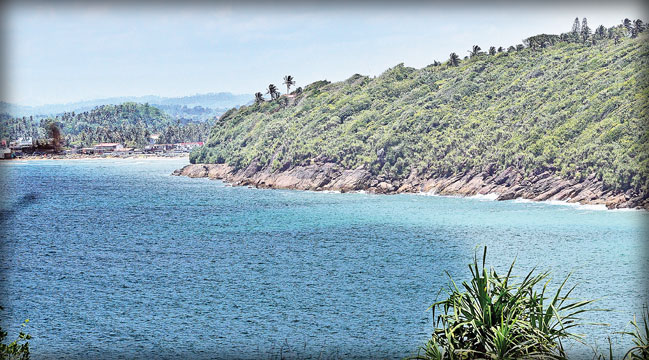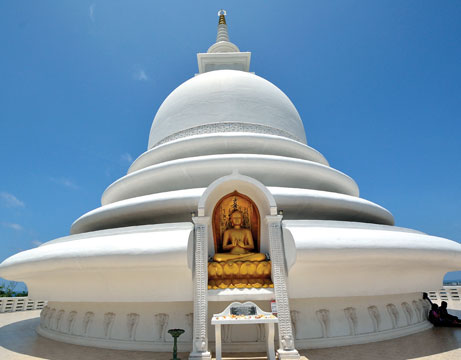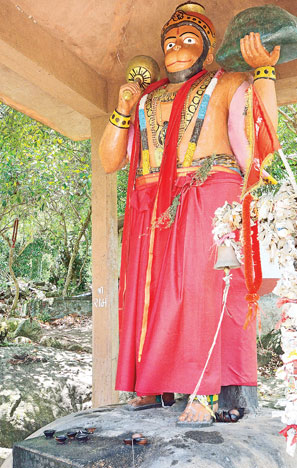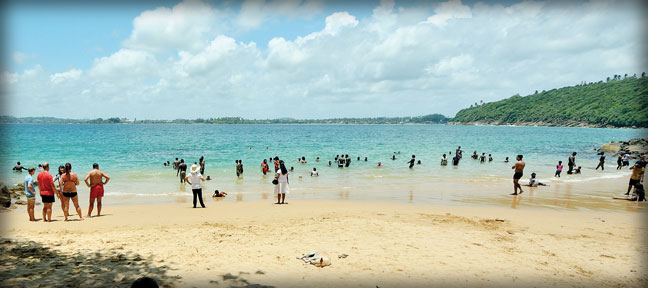|
Rumassala Kanda:
Legend and history: Atop a hillock
Story and pix: Mahil Wijesinghe
 While returning to Weligama from the colonial masterpiece of Galle
Fort on the Southern coastal belt recently via the Galle-Matara main
road, a huge hillock, away from the main road, caught my attention. We
could spot a small but elegant Dagaba on the top and something told us
this could turn out to be a surprise destination. While returning to Weligama from the colonial masterpiece of Galle
Fort on the Southern coastal belt recently via the Galle-Matara main
road, a huge hillock, away from the main road, caught my attention. We
could spot a small but elegant Dagaba on the top and something told us
this could turn out to be a surprise destination.
Tracing the spot through GPS and on enquiry from the roadside vender
we were told it was the Rumassala Kanda - a huge rocky outcrop that
derives its name from the mythological warrior King Hanuman in the
Ramayana.
We decided to explore the place even as the friendly vender advised
us that the path leading to the base of the hillock is partially
motorable and the downward climb is strenuous. What's more, the sun was
beating down mercilessly.
Without heeding his friendly advice, we geared ourselves to traverse
the narrow carpeted road off the highway. We passed groves of
vegetation, and soon reached the base of the hillock, which is
surrounded by thorny bushes and huge trees.
Finally, we reached the green forested hill sloping down to a sandy
beach, a rocky headland pounded by the waves of the mighty Indian Ocean.
We were greeted by panoramic views across a bay dotted with fishing
boats bobbing in the ocean swell. There is only place along the South
coast that provides all this scenery plus a timeless legend that spans
two countries - the enchanting and historical Rumassala Kanda.
|

The enchanting Buddhist Dagaba popularly known as Japanese
Sama Chaitya (peace pagoda). |
In the colonial period, Rumassala was known as Buenos Vista ("Good
View"). Regardless of origin, it is indeed an accurate description of
the place, for the top of Rumassala Kanda offered what was arguably the
best coastal view along the Southern coast of Sri Lanka. The calm waters
of Galle bay provided safe anchorage for numerous foreign vessels
sailing in the Indian Ocean, transporting vast quantities of spices and
precious stones. It is said that during this period, sailors of the
vessels used the southern end of Rumassala Kanda known as Watering Point
to take fresh water before setting off on their long voyages. The ruins
of the old jetty can still be seen today.
The small graveyard on the hill contains the final resting places of
many British civil servants and sailors. Reading these inscriptions
provide an interesting insight into the past of Galle and the people who
lived there. Both the lush vegetation and the ocean around Rumassala
Kanda are rich in biodiversity. The forest is home to many endemic
species of birds, reptiles and mammals as well as rare medical plants.
At the base of the cliff and the calm waters of Indian Ocean are coral
and rocky reefs harbouring a wealth of marine biodiversity. It is
believed that over 530 varieties of fish had been identified here.
Leatherback and Hawksbill turtles are the two main varieties of turtles
identified from this area.
Although the coral reef has been badly affected over the past years
by both human and nature causes it still provides interesting snorkeling
to explore the underwater world. The surrounding areas of Rumassala
Kanda including both the forest and coral reefs are now protected as a
sanctuary due to its valuable biodiversity.
Rumassala Kanda is also steeped in many legends, folklore and
interesting narrations. According to the Ramayana, the ancient Sanskrit
epic, Hanuman the Indian monkey warrior god was sent back to India to
fetch some medical herbs from Himalaya to heal Lakshman who was wounded
in his great battle with demon King Ravana to save the abducted Princess
Sita. While bringing the required herbal plants he accidently dropped it
at Rumassala Kanda. The villagers attributed this as a source of many
rare medical plants found in the area to date and some vouch that the
only other place that some plants from Rumassala are found is the
Himalayas in Nepal.
|

The statue of God Hanuman close to the peace pagoda in
Rumassala Kanda. |
To express your devotion and veneration to the God Hanuman, a large
statue about 15 ft. in height depicting of God Hanuman has been
constructed under the roofed structure in the entrance to the Peace
Pagoda in the Rumassala Kanda. Here, we spotted a large number of
devotees knotting vows (coins knotted with strap of cloth) on a stick,
lighting oil lamps and offering Pujaas to the God Hanuman.
Now it was a trifle intimidating, as we were at a loss as to how and
where to begin our climb. Walking around, we came to junction which
branched off three directions. One road led upward and another downward.
We proceed downward and found a large Buddhist Dagaba popularly known
as the Sama Chaitya (Japanese Peace Pagoda) which is the most striking
landmark of the Rumassala Kanda, built with the assistance of Japanese
monks. At the entrance to the temple on can see a statue of God Hanuman.
We took a break sitting on the upper terrace of the peace pagoda,
taking in the beauty of panoramic view under a cloudless blue sky. It
was breezy spot to sit and enjoy the view. The sea below us looked
beautiful with waveless emerald calm waters all around the Galle Bay
flanked by the dense forest of Rumassala Kanda.
There is a staircase to the Dagaba and we walked around it. There are
four Buddha statues in the cavities around it and they indicate the
Birth, Enlightenment and the Parinibbana (Passing Away) of the Buddha.
Walking around the upper terrace of the peace pagoda, we could catch the
magnificent views across the Galle Bay, with Galle town and the Dutch
Fort visible on the far side.
The adjoining shrine room of the Peace Pagoda houses varieties of
gold plated Buddha statues of different sizes. A Japanese Buddhist monk
is residing in the temple. All the visitors who step into this shrine
room are offered a bunch of sweet candy. Most of the visitors to
Rumassala Kanda never forget to visit this enchanting peace pagoda.
Travelling further upward from the peace pagoda is another Buddhist
temple call Sri Vivekaramaya of Rumassala which also contains some
interesting statues. One is the statue of God Hamuman while others are
statues of Buddha in different postures.
On the way to this temple through a narrow winding road up the hill,
we also stepped into the Rumassala Natural Field Centre which provides
educational information about the biodiversity of Rumassala Kanda and
surrounding areas for schoolchildren and other visitors.
|

Local and foreign visitors enjoy the sea bathing in sandy
beach of Rumassala Kanda. |
From near the Peace Pagoda, a pebbled, dusty track leads through
coastal scrub down to the sandy beach. Here the sea is calmer providing
better swimming and snorkeling conditions all year around. We saw a
large number of foreign and local visitors enjoy swimming in the beach
under the midday sun.
Rumassala Kanda is a haven for genuine nature lovers to enjoy her
natural resources. Tragically, Rumassala Kanda is gravely polluted.
Although the Department of Wildlife Conservation has erected a notice
board advising the visitors not to pollute the place, no one is pays
attention on it. We haven't seen any genuine nature lovers who have so
far stepped on this plot of land. Instead, what we saw was heap of
garbage dumps- plastic bottles, plastic wrappers, empty beer cans etc.
However, as a responsible visitor, you have a duty to protect its
environment while enjoying the pristine beauty all year around. In spite
of the unkind intervention by man in the development programs, historic
Rumassala Kanda has still retained its character as a place of beauty.
|

